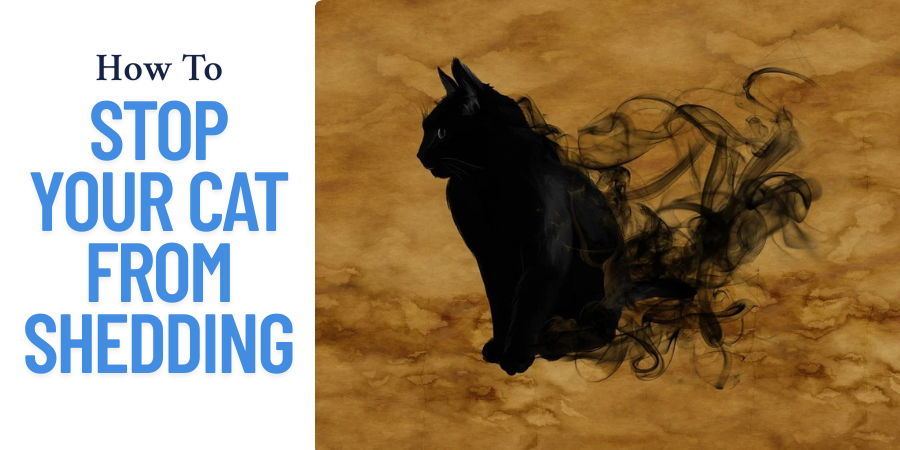Owning a cat brings joy, but also a struggle with shedding. That hair lands everywhere — on clothes, furniture, and floors. Staying ahead with regular vacuuming helps keep your home clean. It’s a big part of pet parenting, and though it’s a challenge, it also deepens your bond.
The perks of living with a feline friend are many, despite the extra effort. Regular brushing reduces stray hairs, saves time, and keeps your cat happy. With the right tips, you can control shedding and enjoy stress-free cuddles.
Contents
- 1 How to stop my cat from shedding
- 1.1 Why do cats shed?
- 1.2 When is cat shedding season?
- 1.3 Does health affect shedding in cats?
- 1.4 Does diet affect how much cats shed?
- 1.5 How do cat grooming habits impact shedding?
- 1.6 Quick tips for managing cat shedding
- 1.7 Treatment for excessive shedding in cats
- 1.8 Can I clip my cat to reduce shedding?
- 1.9 FAQs
How to stop my cat from shedding
Tired of finding cat hair everywhere? Discover simple, effective ways to stop your cat from shedding too much. From daily grooming to smart diet changes, we’ve covered it all just ahead!
Why do cats shed?
It’s not unusual for cats to go through a seasonal shedding cycle, especially during spring and fall. I’ve noticed my own feline friend starts dropping hair in small clumps as the coats grow thinner after winter or thicken again before it. This renewed growth is part of a healthy coat pattern, and it’s completely normal unless there’s sudden loss or falling that seems out of place.
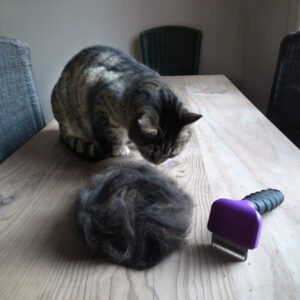
But when shedding feels more like a problem, it might be time to schedule a visit to a vet. The All About Cats Veterinary Hospital once helped me spot early health concerns I didn’t know could develop from abnormal fur patterns. Regular checkups ensure your cat stays healthy and sound, and treating anything early keeps you ahead of serious issues.
When is cat shedding season?
Like many cats, mine goes through noticeable hair growth cycles each year, and it’s all linked to temperature and seasonal shedding. In spring, that thick winter coat starts to loosen as rising temperatures signal a shift toward warmer weather, helping her stay cooler and avoid overheat-related health issues.
Come autumn, the summer coat gives way to a thicker growth, ensuring she’s ready for the colder months with a warmer coat. This natural shift in coat and old fur is part of her internal clock, and with consistent grooming, I’ve found it’s easier to manage the seasonal transitions without being buried in fur.
Does health affect shedding in cats?
In my years of caring for cats, I’ve seen firsthand how health can deeply impact shedding. If your feline friend starts losing clumps of fur, it could be a signal of underlying illness, pain, or discomfort. Owners should watch for unusual shedding patterns, especially when paired with symptoms like licking, scratching, or sore, red patches on the skin—common signs of allergies such as food allergies, flea or insect bite allergies, environmental allergies, atopy, or contact allergies.

Increased shedding may also relate to internal issues like hormonal imbalances, overactive thyroid, or problems with adrenal glands, often resulting in a thin coat or poor condition. Diabetes and other disorders can affect coat health, so if you’re concerned, book a check-up. A vet can run tests, diagnose the issue, and offer targeted treatment. Many clinics, including Pet Health Club, offer year-round plan benefits to help monitor coat condition, prevent self-trauma, and address shedding concerns with early intervention tailored to your cat’s needs, ensuring a healthy cat and a healthy coat.
Does diet affect how much cats shed?
One thing I’ve learned through cat care is that what’s in the bowl matters just as much as grooming. A balanced diet packed with essential nutrients can make a real difference in how much a cat might shed. Since cats are obligate carnivores, high-quality protein from chicken, turkey, or fish supports growth, repair, and a strong, shiny coat. Look for cat food labeled complete and balanced, suited to your pet’s age and lifestyle.
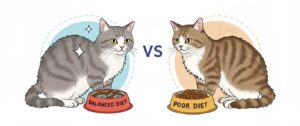
To keep fur glossy, moisturised, and reduce flaky skin, I always check for omega-3 fatty acids from fish oils or flaxseed. Make sure your cat stays hydrated with fresh water—drinking water is often overlooked, but it plays a role in preventing dry skin and excessive shedding. Avoid overfeed habits to prevent obesity, which is linked to skin and coat problems. Every cat has unique dietary needs, so always consult a vet for tailored advice on meeting their specific needs. Sometimes, cats show aggression when eating. If your cat is also suffering from the same situation, you can read our latest article on How to Stop Food Aggression in Cats
How do cat grooming habits impact shedding?
When it comes to cats, their grooming habits are deeply tied to their hygiene and directly affect shedding. They constantly lick themselves using tongue surfaces covered in hook-like structures to keep their fur clean, remove loose fur, and maintain a healthy coat. This natural grooming also helps distribute essential oils across their skin, keeping it shiny and healthy. However, too much of this can lead to excessive grooming, hairballs, and even more shedding.
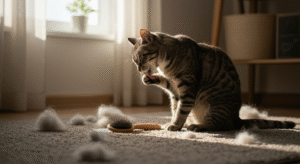
From my experience, a stressed or anxious cat may groom obsessively, which can result in build-up in the stomach, odd behavior around the litter tray, or signs of pain. I’ve found that providing hiding spaces, high spots, and a relaxed environment can really help. Also, speak with your vet about supplements, diets, or underlying medical conditions if you notice sudden changes. Proper grooming removes dirt, debris, and keeps shedding under control while supporting their digestive system and emotional rest.
Quick tips for managing cat shedding
Dealing with food aggression in cats can be tough for pet parents. Many struggle with growling, biting, or hissing during mealtime. But don’t worry! With the right training and consistency, you can help your cat feel more secure.
- Use positive reinforcement when your cat behaves calmly around food.
- Feed on a schedule to avoid confusion and reduce stress.
- Create separate feeding areas for multiple cats to prevent territorial behavior.
- Offer puzzle feeders to slow down fast eaters and reduce competition.
- Keep a calm environment during meals to reduce anxiety.
- Avoid punishment, as it increases fear and aggression.
- Train with clicker training to build trust and good behavior.
- Watch for signs like swatting, lunging, or tense posture.
- Consult a veterinarian if sudden aggression appears—it could be a sign of pain or illness.
- Try desensitization techniques for cats triggered by humans near their food.
- Maintain a consistent feeding routine to build security.
- Use interactive toys to burn off extra energy before meals.
- Add high-value treats to show that being near others while eating brings rewards.
- Feed in quiet spaces away from distractions.
- Observe your cat’s body language to notice what causes food aggression.
- If needed, contact a feline behaviorist for expert guidance.
- Be patient—breaking food-related dominance takes time.
- Keep meals short and focused to prevent overstimulation.
- Offer measured portions to reduce resource-guarding instincts.
- Always approach feeding with kindness and understanding.
Treatment for excessive shedding in cats
When your cat sheds more than usual, it can feel like a never-ending battle to manage it. Although shedding is a natural process, I’ve learned through experience that regular brushing makes a huge difference—it helps remove loose fur and dead fur before it covers your furniture and clothes.
Brushing also spreads natural oils across the fur, keeping the coat healthy and shiny. During grooming, always check for injuries or parasites, especially in outdoor cats, such as cuts, scrapes, open wounds, or sores. If you spot fleas, ticks, mites, or missing hair, visit a vet. These bites or unusual signs on the skin and coat often signal something more serious.
Can I clip my cat to reduce shedding?
While clipping might seem like a quick fix for shedding, it’s not always the safest or most effective route. For double-coated cats, removing the topcoat, guard hairs, and undercoat can leave them unprotected from the sun, scratches, and other environmental hazards. I’ve seen cases where cats were clipped too short, and their insulation, both for cool and warm weather, was lost, leaving them uncomfortable for weeks or even months.
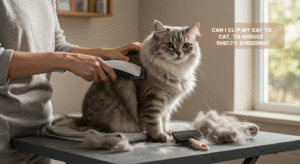
If your cat has matted fur, a careful trim using scissors under a vet team’s guidance might be needed, possibly with sedation if the cat is not comfortable being groomed. However, training your cat to tolerate grooming on a regular basis is a more manageable long-term solution. Letting hair grow back naturally allows hairs to be replaced gradually, maintaining their protective course and natural coat cycle.
Conclusion:
If you’re still asking, “How to stop my cat from shedding,” the answer lies in consistent grooming, feeding a balanced diet, and reducing stress at home. With a little care and the right routine, you can manage shedding and keep your cat’s coat healthy and clean.
FAQs
How to reduce cat hair in home?
A vacuum made specifically for pet hair and dander is a great tool for drastically reducing cat hair and animal hair in your home. Regular cleaning of furniture, carpets, and floors with an effective vacuum cleaner controls hair buildup and hair clumps, improving the indoor environment by reducing allergens. Pair this with regular grooming for better hair management and less shedding, keeping your space clean.
What to feed cats to stop shedding?
Ensuring your cat gets enough protein is key to maintaining a healthy coat and reducing excessive shedding. Hair is primarily made of keratin, a type of protein, so feeding your feline a balanced diet with at least 45% protein on a dry matter basis supports fur growth, maintenance, and a shiny coat. When choosing cat food, check the labels for quality protein sources and essential nutrients like amino acids that aid digestion and absorption to promote skin health and overall vitality.
Do baths help cats stop shedding?
Regular bathing effectively reduces shedding by removing loose hair, dirt, and allergens from your cat’s fur, keeping furniture clean while supporting skin health and preventing skin infections and irritation. This essential grooming and cleanliness routine enhances coat appearance, making fur shinier, softer, and well-moisturized, which improves overall pet comfort, fur condition, and long-term shedding control. Maintaining proper bathing frequency ensures effective hair removal, protects skin moisture, and promotes healthy coat maintenance and pet hygiene.
What months do cats shed the most?
Understanding your cat’s hair growth cycles like a biological clock helps in managing shedding effectively, especially during March, May, September, and November when fur naturally molts. It’s a good idea to spend a short period each day brushing your cat to lessen the amount of hair shed around the home. This routine keeps the fur clean and reduces the usual excessive shedding over these critical months.

